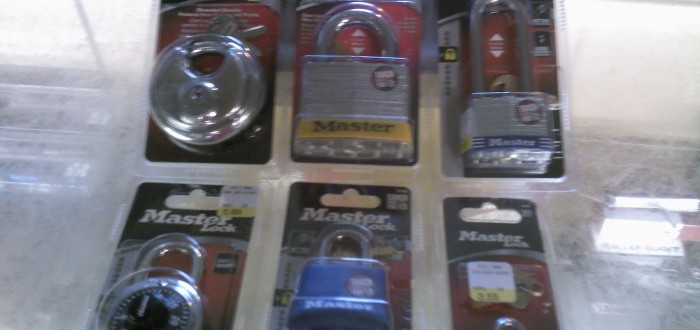As I was unpacking a customer’s order of keyed-alike padlocks, it occurred to me that we hadn’t covered a very common item around the home and farm, padlocks. A wise man once said, “Locks are for keeping honest people honest.” This can be true as real crooks aren’t deterred much by many locks. They have tools and tricks to get around many security devices, however a good lock can slow down a thief and sometimes convince them to look for easier pickings elsewhere. Today we’ll cover common padlocks that can help you protect your property.
Padlocks are devices that have existed since ancient times. Egyptian and Roman peoples used padlocks to keep thieves away from their valuables. Basically a padlock consists of a open ring of metal, the shackle, with a way to close it and lock it shut to form a complete ring. The body of the padlock consists of the locking portion and the mechanism, keyed, combination or other.
Keyed padlocks are the least expensive and most common type. They take a metal key, similar to a door key to unlock the mechanism to open them. Most keys can be copied in case you loose one or need extras, but beware of the least expensive locks that are “warded”, they take a flat metal key that is cut on both sides. They work well in low security applications, but the keys are not copyable and if you loose one or need extras you are out of luck. Keyed padlocks range from small and cheap to quite large and expensive. Their security capacity ranges the same way. The more you spend, the bigger and more secure lock you will get.
The smallest locks usually have a brass body and the shackle locks only on one end. These can be pried open and are best used for low security applications like keeping the kids out of your toolbox and the like. Better locks lock the shackle on both ends and are “pry-resistant”. These are the larger brass padlocks and those of laminated steel construction. The laminated type locks are made of many thin sheets of steel riveted together and while inexpensive to make are quite hard to get open. These are the common “Master” type locks and their many imitators that most people are familiar with. The better or high security locks have solid steel cases and high precision lock mechanisms. Many high end locks feature trick features such as roller or protected shackles or special hard to pick keyways.
Combination locks are also available that eliminate the need for a key. The regular right-left-right variety have a set combination, but locks that take a single number or word setting and can be reset are convenient. I use these on my out buildings and find them very handy. I used to use regular locks and would often walk all the way to the back of the property and find that I had left the key in the house, now I don’t need a key.
Methods of defeating locks run the gamut depending on the type of lock. Cheap ones can often be pried open. Better locks can have the shackle cut. Good locks have case hardened shackles that resist cutting and must be ground open, but this takes a grinder and is noisy. Key type locks can be picked, but it’s a lot harder than it looks in the movies, and most thieves don’t know how or won’t take the time. Master has a great commercial where their locks resist being shot, but I’ve tried it just out of curiosity and so far mine have had a a perfect record, if you shoot them with a high powered rifle they open every time, and it’s sometimes hard to find the lock afterwards! By the way, make sure that the lock hasp or chain that you use is as stout as your lock, it is sometimes easier to break the hasp out of the door or cut the chain to get it open without even opening the lock.
That’s about it for keeping your things secure. Just use this information to evaluate the level of security you think that you need, and purchase your lock accordingly. It will help keep the honest people honest, and if the real crooks want your stuff, at least make them work for it.

